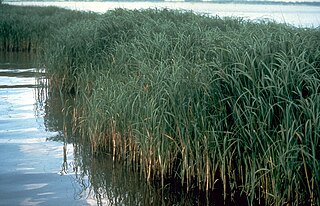
A halophyte is a salt-tolerant plant that grows in soil or waters of high salinity, coming into contact with saline water through its roots or by salt spray, such as in saline semi-deserts, mangrove swamps, marshes and sloughs and seashores. The word derives from Ancient Greek ἅλας (halas) 'salt' and φυτόν (phyton) 'plant'. An example of a halophyte is the salt marsh grass Spartina alterniflora. Relatively few plant species are halophytes—perhaps only 2% of all plant species.

Amaranthaceae is a family of flowering plants commonly known as the amaranth family, in reference to its type genus Amaranthus. It includes the former goosefoot family Chenopodiaceae and contains about 165 genera and 2,040 species, making it the most species-rich lineage within its parent order, Caryophyllales.
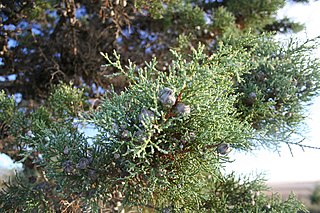
Cypress is a common name for various coniferous trees or shrubs of northern temperate regions that belong to the family Cupressaceae. The word cypress is derived from Old French cipres, which was imported from Latin cypressus, the latinisation of the Greek κυπάρισσος (kyparissos).

Salicornia is a genus of succulent, halophyte flowering plants in the family Amaranthaceae that grow in salt marshes, on beaches, and among mangroves. Salicornia species are native to North America, Europe, South Africa, and South Asia. Common names for the genus include glasswort, pickleweed, picklegrass, and marsh samphire; these common names are also used for some species not in Salicornia. To French speakers in Atlantic Canada, they are known, colloquially, as "titines de souris". The main European species is often eaten, called marsh samphire in Britain, and the main North American species is occasionally sold in grocery stores or appears on restaurant menus, usually as 'sea beans' or samphire greens or sea asparagus.

Batis is a genus of two species of flowering plants, the only genus in the family Bataceae. They are halophytic plants, native to the coastal salt marshes of warm temperate and tropical America and tropical Australasia.
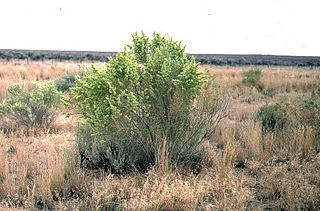
Saltbush is a vernacular plant name that most often refers to Atriplex, a genus of about 250 plants distributed worldwide from subtropical to subarctic regions. Atriplex species are native to Australia, North and South America, and Eurasia. Many Atriplex species are halophytes and are adapted to dry environments with salty soils.

Salsola soda, more commonly known in English as opposite-leaved saltwort, oppositeleaf Russian thistle, or barilla plant, is a small, annual, succulent shrub that is native to the Mediterranean Basin. It is a halophyte that typically grows in coastal regions and can be irrigated with salt water.

Kali turgidum, commonly known as prickly saltwort or prickly glasswort, is an annual plant that grows in salty sandy coastal soils.

Barilla refers to several species of salt-tolerant (halophyte) plants that, until the 19th century, were the primary source of soda ash and hence of sodium carbonate. The word "barilla" was also used directly to refer to the soda ash obtained from plant sources. The word is an anglicization of the Spanish word barrilla for saltwort plants.

Atriplex halimus is a species of fodder shrub in the family Amaranthaceae, widespread through the Mediterranean Basin, North and East Africa and the Arabian Peninsula. This plant is often cultivated as forage because of its tolerance for severe conditions of drought, and it can grow easily in very alkaline and saline soils. In addition, it is useful to valorize degraded and marginal areas because it will contribute to the improvement of phytomass in this case.

Suaeda is a genus of plants also known as seepweeds and sea-blites. Most species are confined to saline or alkaline soil habitats, such as coastal salt-flats and tidal wetlands. Many species have thick, succulent leaves, a characteristic seen in various plant genera that thrive in salty habitats.
Pickleweed is a common name used for two unrelated genera of flowering plants:

The glassworts are various succulent, annual halophytic plants, that is, plants that thrive in saline environments, such as seacoasts and salt marshes. The original English glasswort plants belong to the genus Salicornia, but today the glassworts include halophyte plants from several genera, some of which are native to continents unknown to the medieval English, and growing in ecosystems, such as mangrove swamps, never envisioned when the term glasswort was coined.

Salsola is a genus of the subfamily Salsoloideae in the family Amaranthaceae. The genus sensu stricto is distributed in central and southwestern Asia, North Africa, and the Mediterranean. A common name of various members of this genus and related genera is saltwort, for their salt tolerance. The genus name Salsola is from the Latin salsus, meaning "salty".
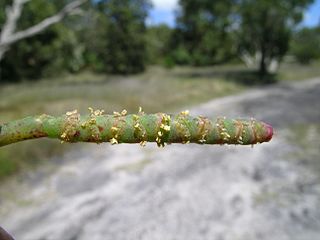
Sarcocornia quinqueflora, commonly known as beaded samphire, bead weed, beaded glasswort or glasswort, is a species of succulent halophytic coastal shrub. It occurs in wetter coastal areas of Australia and New Zealand.
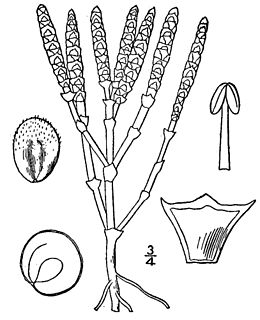
Salicornia bigelovii is a species of flowering plant in the family Amaranthaceae known by the common names dwarf saltwort and dwarf glasswort. It is native to coastal areas of the eastern and southern United States, Belize, and coastal Mexico. It is a plant of salt marshes, a halophyte which grows in saltwater. It is an annual herb producing an erect, branching stem which is jointed at many internodes. The fleshy, green to red stem can reach about 60 cm in height. The leaves are usually small plates, pairs of which are fused into a band around the stem. The inflorescence is a dense, sticklike spike of flowers. Each flower is made up of a fused pocket of sepals enclosing the stamens and stigmas, with no petals. The fruit is an utricle containing tiny, fuzzy seeds. The southern part of the species range is represented by the Petenes mangroves of the Yucatán, where it is a subdominant plant associate in the mangroves.
Salsola kali was the botanical name for a species of flowering plants in the amaranth family, whose subspecies have been recently reclassified as two separate species in the genus Kali:

Salicornia europaea, known as common glasswort or just glasswort, is a halophytic annual dicot flowering plant in the family Amaranthaceae. Glasswort is a succulent herb also known as ‘Pickle weed’ or ‘Marsh samphire’. As a succulent, it has high water content, which accounts for its slightly translucent look and gives it the descriptive name “glasswort.” To some people, it is known as “chicken toe” because of its shape. To others, it is called “saltwort.” It grows in various zones of intertidal salt marshes, on beaches, and among mangroves.

Bulrushes is the vernacular name for several large wetland grass-like plants in the sedge family (Cyperaceae).













